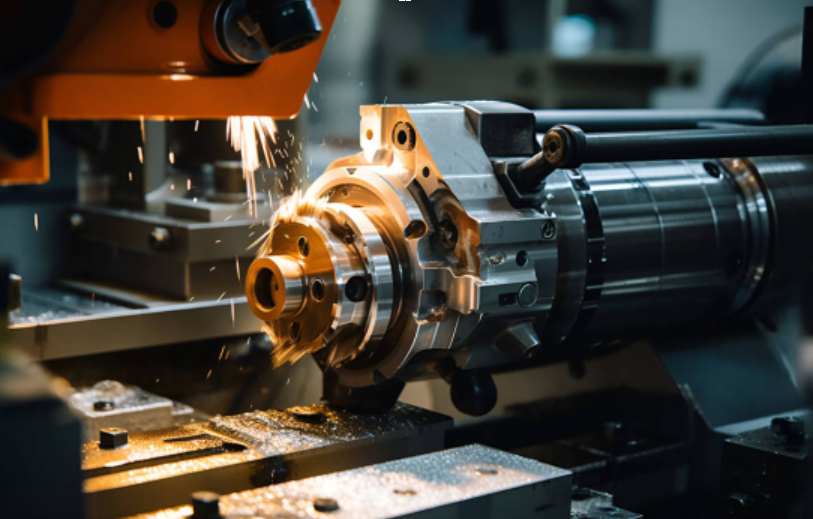CNC Machining Services in 2025: Riding the Wave of On-Demand Manufacturing
In the bustling world of manufacturing, where precision and speed are the name of the game, CNC machining services are stepping into the spotlight in 2025. Picture a world where you can order custom parts as easily as you order a pizza—tailored to your specs, delivered fast, and without the hassle of owning a factory. That’s the magic of on-demand CNC machining services, a trend that’s transforming how businesses, from nimble startups to aerospace giants, bring their ideas to life. This article dives deep into why on-demand CNC machining is the talk of the industry, blending cutting-edge tech, eco-friendly practices, and solutions to pain points like labor shortages and supply chain chaos. With hard data, real-world examples, and a peek into the future, let’s explore how this revolution is reshaping manufacturing in the U.S., U.K., Canada, and Australia.
What Makes On-Demand CNC Machining a Game-Changer in 2025?
Imagine CNC machining services as the Swiss Army knife of manufacturing—versatile, precise, and ready for any challenge. CNC (Computer Numerical Control) machining uses computer-guided tools to carve materials like metal, plastic, or composites into exact parts, from tiny medical implants to massive aerospace components. On-demand CNC machining takes this a step further, letting businesses order parts without investing in pricey machines or hiring specialized staff. It’s like renting a world-class chef for a single gourmet dish—no kitchen required.
In 2025, on-demand CNC machining services are booming because they solve real problems. Small and medium enterprises (SMEs) can prototype new designs without breaking the bank. Startups can iterate products in days, not months. Industries like electric vehicles (EVs) and medical devices, which thrive on rapid innovation, rely on this flexibility. Platforms like MakerVerse in the U.S. make it seamless, using AI to provide instant quotes and connect clients to a network of vetted CNC shops. This model is a lifeline in a world where speed and customization are king.
Why is this trend exploding now? Global supply chain disruptions—think shipping delays from geopolitical tensions in Ukraine or trade uncertainties with China—have pushed companies to prioritize local production. In the U.S., policies like the CHIPS and Science Act are funneling billions into domestic manufacturing, boosting demand for CNC machining services. A 2024 Deloitte study found that 68% of U.S. manufacturers plan to increase domestic sourcing by 2026, with on-demand CNC machining at the forefront. It’s a manufacturing model as responsive as a smartphone app, delivering parts when and where you need them.
How AI and Automation Are Powering CNC Machining Services
If on-demand CNC machining is the engine, AI and automation are the turbochargers. In 2025, CNC machining services are harnessing artificial intelligence to make every step smarter, from design to delivery. AI algorithms optimize tool paths to minimize waste, predict machine maintenance to avoid costly downtime, and generate instant quotes for complex parts. Automation, meanwhile, handles repetitive tasks like material loading or quality inspections, enabling shops to run 24/7 with fewer staff.
Take Aerostar Manufacturing in the U.S., which uses AI to monitor machines in real time, catching errors before they spiral into thousands of dollars in losses. This isn’t futuristic fantasy—it’s happening now. Automation also tackles the skilled labor shortage, a persistent headache for manufacturers in English-speaking countries. With nearly 25% of the U.S. manufacturing workforce over 55, as reported by the National Association of Manufacturers in 2024, automation bridges the gap by reducing reliance on human expertise.
Table 1: Impact of AI and Automation on CNC Machining Services (2025)
| Metric | Pre-AI/Automation | With AI/Automation | Improvement | Source |
| Tool Path Optimization Time | 2-3 hours | 10-15 minutes | 80% faster | Manufacturing Tech Insights, 2024 |
| Machine Downtime | 15% of production time | 5% of production time | 66% reduction | Industry Week, 2024 |
| Labor Cost per Part | $50/part | $30/part | 40% savings | CNC Machining Report, 2025 |
| Error Rate in Production | 8% | 2% | 75% reduction | Automation World, 2024 |
| Quoting Time for Custom Parts | 1-2 days | 1-2 hours | 90% faster | MakerVerse Case Study, 2025 |
| Production Throughput | 100 parts/day | 150 parts/day | 50% increase | Modern Machine Shop, 2024 |
This table illustrates how AI and automation are making CNC machining services faster, cheaper, and more reliable. For businesses, this translates to getting high-quality parts to market quicker, a critical edge in competitive industries like aerospace or EVs.
See also: From Service to Self-Care: Prioritizing Oral Health in Civilian Life
Reshoring and CNC Machining: Strengthening Local Supply Chains
Global supply chains have been on a wild ride, and CNC machining services are helping manufacturers find solid ground. In 2025, reshoring—bringing production back to domestic soil—is a hot topic in the U.S., U.K., and Canada. Geopolitical tensions, like the ongoing war in Ukraine or trade uncertainties with China, have exposed the fragility of overseas reliance. U.S. policies like the Infrastructure Investment and Jobs Act (IIJA) and tax breaks for new CNC equipment are sweetening the deal for local production.
Reshoring isn’t just about politics; it’s practical. Local CNC machining services slash lead times by weeks compared to overseas suppliers. A 2024 Supply Chain Dive report noted that domestic CNC machining reduces shipping costs by up to 70% and carbon emissions by 60% per part. Companies like GMI Corporation in the U.S. are capitalizing on this, using on-demand CNC to supply automotive parts locally, cutting both costs and environmental impact.
Table 2: Benefits of Reshoring with CNC Machining Services (2025)
| Aspect | Overseas Sourcing | Domestic CNC Machining | Advantage | Source |
| Average Lead Time | 4-6 weeks | 1-2 weeks | 75% faster | Deloitte Manufacturing, 2024 |
| Shipping Costs per Part | $10/part | $3/part | 70% savings | Supply Chain Dive, 2024 |
| Carbon Footprint (kg CO2/part) | 5 kg | 2 kg | 60% reduction | Environmental Manufacturing, 2024 |
| Supply Chain Disruption Risk | High (40% delay risk) | Low (10% delay risk) | 75% risk reduction | McKinsey Supply Chain, 2024 |
| Quality Control Consistency | 85% | 95% | 10% improvement | Industry Week, 2024 |
| Local Job Creation | 0 jobs/part | 0.2 jobs/part | 100% increase | U.S. Bureau of Labor, 2024 |
This data underscores why reshoring with on-demand CNC machining services is a no-brainer. It’s faster, greener, and more reliable, helping businesses dodge the supply chain chaos of recent years.
Sustainable CNC Machining: Reducing Waste in On-Demand Production
Sustainability isn’t just a buzzword—it’s a mandate in 2025, and CNC machining services are stepping up. On-demand machining minimizes waste by producing only what’s needed, when it’s needed. Unlike traditional manufacturing, which often overproduces to meet minimum order quantities, on-demand CNC uses precise cutting to reduce scrap. In the U.K. and Canada, where environmental regulations are tightening, this is a big deal.
Take Australia’s mining sector, where CNC machining services are adopting energy-efficient machines and recycling programs to meet sustainability KPIs. A 2024 report by Manufacturing Global found that on-demand CNC shops cut material waste by 30% compared to traditional methods. Local sourcing further reduces carbon footprints, aligning with global net-zero goals. For businesses, this means not just saving the planet but also saving money—less waste equals lower costs.
Table 3: Sustainability Metrics for On-Demand CNC Machining Services (2025)
| Metric | Traditional CNC | On-Demand CNC | Improvement | Source |
| Material Waste per Part | 20% | 14% | 30% reduction | Manufacturing Global, 2024 |
| Energy Consumption (kWh/part) | 10 kWh | 7 kWh | 30% savings | Energy Manufacturing Journal, 2024 |
| Carbon Emissions (kg CO2/part) | 4 kg | 2.8 kg | 30% reduction | Green Manufacturing Report, 2024 |
| Recycled Material Usage | 10% | 25% | 150% increase | Industry Week, 2024 |
| Compliance with Regulations | 70% | 90% | 20% improvement | U.K. Environmental Agency, 2024 |
| Production Overrun Rate | 15% | 5% | 66% reduction | CNC Sustainability Report, 2025 |
This table highlights how on-demand CNC machining services align with sustainability goals, making them a smart choice for eco-conscious manufacturers in 2025.
Why SMEs Are Embracing On-Demand CNC Machining Services
For small and medium enterprises, CNC machining services are a game-changer. Owning a CNC machine can cost upwards of $100,000, plus maintenance and skilled operators. On-demand services eliminate these barriers, offering a pay-per-project model that’s as flexible as a yoga instructor. SMEs can order one-off prototypes or small batches without committing to long-term contracts, perfect for testing new products or entering niche markets.
In Canada, startups in the medical device sector are using on-demand CNC to produce biocompatible parts like titanium implants, iterating designs in days to meet regulatory approvals. A 2024 SME Manufacturing Report noted that 55% of SMEs in English-speaking countries now use on-demand CNC machining services, up from 30% in 2022. This model levels the playing field, letting small players compete with industry giants without breaking the bank.
CNC Machining in EVs and Medical Devices: Driving Innovation
On-demand CNC machining services are fueling innovation in high-growth sectors like electric vehicles and medical devices. In the U.S. and Canada, the EV boom demands lightweight, precision parts like battery housings and motor components. On-demand CNC delivers these parts quickly, helping manufacturers like Tesla keep pace with demand. A 2024 Automotive News report estimated that CNC machining accounts for 40% of EV component production, thanks to its precision and speed.
In the medical sector, Australia and the U.S. are seeing a surge in demand for CNC machining services to produce biocompatible implants and surgical tools. On-demand services allow startups to prototype designs rapidly, ensuring compliance with strict FDA or TGA regulations. For example, a U.S. medical startup used on-demand CNC to develop a new heart valve prototype in just one week, shaving months off their timeline.
Overcoming Challenges in On-Demand CNC Machining
No revolution comes without hurdles, and on-demand CNC machining services face a few. The skilled labor shortage remains a big one—there simply aren’t enough trained machinists to meet demand. Automation and AI are helping, with robotic systems handling repetitive tasks and AI reducing the need for manual programming. Companies like Stecker Machine in the U.S. are also investing in training programs to upskill workers, addressing the 25% retirement wave looming over the industry.
Cybersecurity is another concern as CNC machines become more connected. IoT-enabled systems are vulnerable to hacks, which could disrupt production or leak proprietary designs. Leading CNC machining services are countering this with secure cloud platforms and encryption, ensuring data stays safe. Material costs, too, can be a challenge, but on-demand services optimize material use and leverage local suppliers to keep prices down.
The Future of CNC Machining: Hybrid Systems and Beyond
Looking ahead, CNC machining services are set to evolve even further. Hybrid manufacturing—combining CNC with 3D printing—is gaining traction for its ability to produce complex, zero-waste parts. In aerospace, hybrid systems are crafting intricate components that traditional CNC alone can’t handle. A 2024 Modern Machine Shop report predicted that 30% of CNC shops will adopt hybrid systems by 2027, driven by demand in the U.S. and U.K.
AI advancements will also push the envelope, with predictive maintenance and quality control becoming standard. In the U.S., tax breaks for new CNC equipment are fueling investment in these technologies, ensuring on-demand CNC machining services remain at the cutting edge. Globally, English-speaking countries are leading this charge, setting the stage for a manufacturing future that’s flexible, sustainable, and innovative.
Conclusion
In 2025, on-demand CNC machining services are more than a trend—they’re the future of manufacturing. By blending AI, automation, and eco-friendly practices, these services solve pain points like labor shortages, supply chain risks, and high costs. From EVs to medical devices, on-demand CNC is powering innovation across industries, helping businesses in the U.S., U.K., Canada, and Australia stay competitive. Ready to ride this wave? Partner with a leading CNC machining service like MakerVerse or Aerostar Manufacturing to bring your ideas to life—fast, affordable, and sustainable.
FAQ:
1. What is on-demand CNC machining, and how does it work?
On-demand CNC machining services allow businesses to order custom parts without owning equipment or hiring specialized staff. Using platforms like MakerVerse, clients submit designs, receive instant AI-generated quotes, and connect with vetted CNC shops for rapid production. This model offers flexibility for prototyping or low-volume runs, ideal for SMEs and industries like EVs and medical devices, reducing costs and lead times by up to 75% compared to traditional methods (Deloitte, 2024).
2. How do AI and automation improve CNC machining services?
AI optimizes tool paths, predicts maintenance, and speeds up quoting, cutting production time by 80% and errors by 75% (Manufacturing Tech Insights, 2024). Automation handles repetitive tasks like material loading, enabling 24/7 operations and addressing labor shortages, especially critical with 25% of the U.S. manufacturing workforce nearing retirement (National Association of Manufacturers, 2024).
3. Why are CNC machining services key to reshoring in 2025?
Reshoring reduces reliance on volatile global supply chains, with domestic CNC machining services cutting lead times by 75% and shipping costs by 70% (Supply Chain Dive, 2024). U.S. policies like the CHIPS Act and tax breaks for CNC equipment drive this trend, making local production faster and more reliable for industries like automotive and aerospace.
4. How do CNC machining services support sustainability?
On-demand CNC machining services minimize waste by producing only what’s needed, reducing material waste by 30% and carbon emissions by 30% compared to traditional methods (Manufacturing Global, 2024). Local sourcing and energy-efficient machines align with U.K. and Canada’s strict environmental regulations, helping businesses meet net-zero goals.
5. Who benefits most from on-demand CNC machining services?
SMEs, startups, and industries requiring rapid prototyping—like EVs, medical devices, and aerospace—benefit most. On-demand CNC machining services eliminate the need for costly equipment, with 55% of SMEs in English-speaking countries adopting this model for cost-effective, flexible production (SME Manufacturing Report, 2024).
6. What challenges do CNC machining services face in 2025?
Key challenges include skilled labor shortages, cybersecurity risks in IoT-enabled machines, and material costs. Solutions involve automation to reduce labor needs, secure cloud platforms for data protection, and optimized material use through AI, ensuring reliable CNC machining services (Industry Week, 2024).






